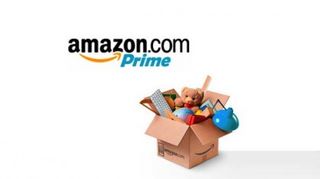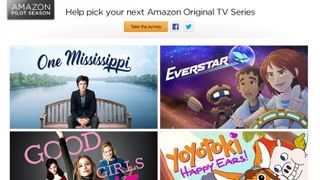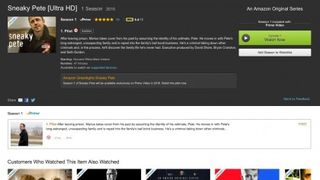Amazon can teach Netflix about the future of TV
Can the student become the master?

I don't know if you know, but Netflix is kind of a big deal. In the US it already accounts for over a third of all peak-time downstream traffic, it's got over sixty-five million subscribers and has penetration in sixty countries with a view to hitting two hundred by the end of 2016.
So yeah, kind of a big deal.
But, while it is pretty much the undisputed king of the video streaming game - with its heady mix of exclusive homebrew programming, big-name TV shows, kids-specific profiles and now its own line of movies - it's not got everything its own way.
When Amazon first picked up Lovefilm and turned it into its own video streaming service, Amazon Prime Instant Video, it was very much an also-ran in terms of the OTT streaming race. But over the last year or two the service has started to go from strength to strength.
Amazon has tidied up its desktop application to make it more transparent (pun fully intended) and more in line with Netflix's super easy-to-navigate interface, and its video service is now bundled in with arguably the best-value package in all of tech, Amazon Prime. At £79 for the year that's only just over a fiver more expensive than Netflix's most basic package for a year.

That's all good, but does highlight how Amazon has mostly just been playing catch up to its big rival, the Netflix streaming giant.
This year though has seen Amazon begin to take the lead and has now become the place where you can, both literally and figuratively, see the future of television. And in doing so is really taking the fight to Netflix, where it's now going to have to be the one doing the chasing.
Get daily insight, inspiration and deals in your inbox
Get the hottest deals available in your inbox plus news, reviews, opinion, analysis and more from the TechRadar team.
Technology
The biggest shift in TV technology is happening right now and Amazon Prime Instant Video is in the vanguard of the burgeoning push towards high dynamic range (HDR).
HDR has the potential to be of much greater importance than the move from Full HD to Ultra HD. The quality shift from 1080p to 4K hasn't offered the step-change in image fidelity that many had hoped for, certainly nowhere near the jump from standard definition to high-def.

High dynamic range, with its vast range of colours and greater depth in shadows and contrast, can make even 1080p content look far more visually arresting than a simple 4K Ultra HD video.
And there have been HDR-capable TVs on sale for much of this year - from Samsung's gorgeous JS9500 and JS9000 TVs, to Sony's 4K range and LG's mighty OLEDs - and yet where is the content?
On Amazon Prime, that's where.
When it was first announced that Amazon Prime Instant Video would be the first service to offer consumers high dynamic range content only Amazon's Mozart in the Jungle series and the pilot for its Red Oaks 80's comedy show were available. But now pretty much all of its own original series are available with HDR support added in for compatible TVs.
While the HDR standards haven't been finalised - there are at least five different ones being worked out - the HDR 10 version used by Amazon for its Prime Instant Video service is being seen as one of the most effective for streaming. It's likely to be the same standard Netflix will use when it goes HDR next year.
And, unlike Netflix which needs you to be subscribed to the top-tier Premium standard to get access to its Ultra HD content, Amazon Prime's full 4K UHD catalogue, along with its entire HDR range, are available to existing subscribers for no extra cost.

Pilot season
As well as its existing original content all of Amazon Prime Instant Video's latest Pilot Season shows are available in HDR too.
The Pilot Season, now in its fourth iteration, offers subscribers a chance to see potential Amazon Originals before they're made into full seasons.
They can then vote on whether they enjoyed the shows, giving Amazon a huge amount of audience feedback to form its market research and help decide if it should bother commissioning any more.
This Autumn there are twelve new show pilots to check out, ranging from Western revenge stories to 60's feminist revolution to kids adventures. There's a great mix and some potentially interesting new shows which could come out of it.
Not the Western one though. That's rubbish.

Already some of the last pilots have been commissioned for full series, such as Sneaky Pete, the story of an ex-con, con-man who's recently released from prison and assumes the identity of his former cellmate. We've also had early previews of the adaptation of the Philip K. Dick story, The Man in the High Castle, which is now available in full.
It's great that Amazon is giving its audience a sneaky peak at what's potentially arriving on the service in the future, whetting our appetite and giving us a chance to be involved in the decision-making process.
Of course it's not all for our benefit, if at all, because it obviously helps Amazon stop money being spent on properties which the audience has no appetite for.
That's something Netflix maybe should have done with it's hugely expensive original, Marco Polo. That was seen as something of a flop by the critics, although Netflix has defended its show, though has also kept any rating figures close to its chest.
With the power of the sort of audience feedback and user-tracking metrics on offer to the streaming services it makes total sense for Netflix to go ahead and test out shows like Amazon has done.

Netflix is still king
But while Amazon's video platform is making great strides forward, and is pioneering new tech and new ways of testing content, there is no denying that it still has some things it can learn from its biggest rival.
Netflix makes a big deal about the consistent strategy it has across all its varied media. You boot up the Netflix app on your console, your smart TV, your tablet, desktop or laptop and the experience is identical. Sure, there are only certain places where you can get the Ultra HD content, but on the whole it's an utterly consistent experience.
The same cannot be said for Amazon, where it's browser-based version is buried in the standard Amazon store. And, while it has improved, it's still a rather ugly beast when you're searching through the content.
On the app-side the mixing of the freely available with the pay-to-view content can make things rather confusing too. Netflix though is all about making the user-experience as clean and easy as possible - Amazon Prime Instant Video still feels very much like a slightly confused retail experience.
Most Popular



